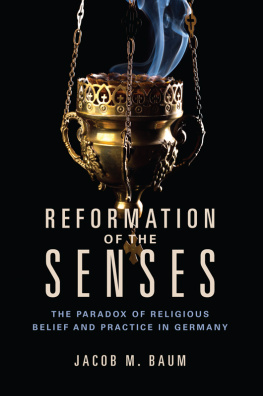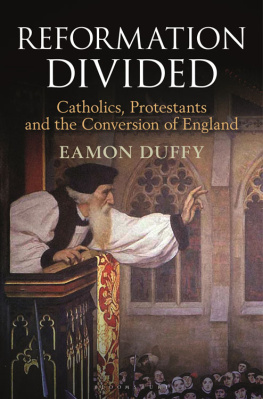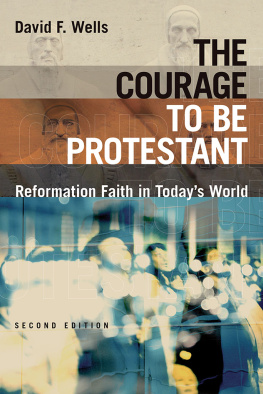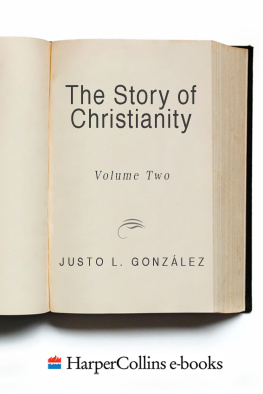Reformation of the Senses
STUDIES IN SENSORY HISTORY
Series Editor
Mark M. Smith, University of South Carolina
Series Editorial Board
Martin A. Berger, University of California at Santa Cruz
Constance Classen, Concordia University
William A. Cohen, University of Maryland
Gabriella M. Petrick, New York University
Richard Cullen Rath, University of Hawaii at Mnoa
A list of books in the series appears at the end of this book.
2019 by the Board of Trustees
of the University of Illinois
All rights reserved
Library of Congress Cataloging-in-Publication Data
Names: Baum, Jacob M., author.
Title: Reformation of the senses : the paradox of religious belief and practice in Germany / Jacob M. Baum.
Description: [Urbana, Illinois] : University of Illinois Press, [2018] | Series: Studies in sensory history | Includes bibliographical references and index.
Identifiers: LCCN 2018020261 | ISBN 9780252042195 (hardcover ; alk. paper) | ISBN 9780252083990 (pbk. ; alk. paper)
Subjects: LCSH : Senses and sensationReligious aspectsChristianityHistory. | Senses and sensationGermanyHistory. | ReformationGermany. | GermanyChurch history.
Classification: LCC BT 741.3 . B 38 2018 | DDC 274.3/06dc23 LC record available at https://lccn.loc.gov/2018020261
E-book ISBN 978-0-252-05093-0
Cover illustration: iStock.com/Studio-Annika
Acknowledgments
Many people made this book possible. My parents, John and Patty, instilled in me from an early age a discipline that was absolutely necessary to seeing this project through to its completion. My success as an academic has been built on the foundations they laid. As I was growing up in western Michigan, friends and family members shaped me in innumerable ways. There are more to be acknowledged than space permits, but Id like to single out my siblings, Mark, Laura, and Zach, and my grandmother, Nancy. Also in western Michigan, I owe a special debt to an individual who will remain anonymous here. Growing up Catholic in this part of the United States, I was sometimes reminded of the differences that separated me from the majority (reformed, Calvinist) Protestant culture, never more so than when, in the course of a high school English class discussion on religion, I was confronted with the question: Dont you people worship statues of the Virgin Mary? I didnt realize it at the time, but this question sowed the seeds that would eventually grow into this book.
My undergraduate education at Aquinas College was instrumental to my formation as a person and intellectual. Above all, I am deeply grateful to my adviser, Charles Gunnoe, who was a model teacher, channeled and nurtured my interests in German and the history of religion in a variety of courses, and offered sage and sober advice about graduate school. I still look to his example when figuring out how to approach my own classes, and I am glad to call him a friend today. Also at Aquinas, I owe very heartfelt thanks to Katharina Husler-Gross, the best teacher of German I could have hoped for. I also want to thank Jason Duncan in History, Deborah Wickering in Anthropology, Jennifer Dawson and Rebecca Coogan in English, and Dennis Marshall in Theology. You were exemplary teachers and scholars, and the care you devoted to me as a student influenced not only the writing of this book, but also my development as a person.
As a graduate student at the University of Illinois, I learned much from both faculty and fellow graduate students and became a more mature scholar. Early in my first semester, I probably would have quit my studies if it hadnt been for Antoinette Burton. The course I took with her that semester profoundly expanded my intellectual horizons, and whether she intended to or not, she taught me to take the discipline of history, and myself, more seriously. Similarly, without Carol Symess early interest and involvement in my work, Im sure I would not have gotten as far as I have. Shes always been more than generous with her time, thoughtful feedback, and enthusiastic support. Tibi gratia mea infinita . The friendships I formed with fellow graduate students, especially Ian Hartman, Dave Bates, Nathan Chio, Ashley Howard, Andy Eisen, and Amanda Eisemann, were also essential for survival. I also greatly benefited from opportunities to work with scholars in History, Medieval Studies, German, and Religion, especially Megan McLaughlin, Dana Rabin, Clare Crowston, Bruce Rosenstock, and Mara Wade. Of course, my greatest thanks go to Craig Koslofsky. He first told me about this new thing called sensory history. Since then, his steadfast enthusiasm for the project has given me the confidence to keep going with it, and if I hadnt been able to talk through parts of it with him, I wouldnt have been able to sort it all out. His work is always before me as the model of imaginative scholarship that treats difficult and complex subjects in a disarmingly accessible, elegant manner. Here I aspire to that model, and I hope I dont fall too short of the mark.
I conducted much of the research for this book while living in Germany from 2010 to 2012. There I enjoyed the generous support of the Leibniz Institute for European History, which, in addition to financial support, provided housing, a stimulating intellectual climate, and very friendly support from a community of fine scholars: special thanks to Luka Ilic, Henning Jrgens, Irene Dingel, Esther Mller, Lorenz Baibl, and the entire library staff at the Institute. The Center for Library and Information Resources in Washington, D.C., also provided substantial financial support that enabled further research in Germany. Among the many helpful library and archival staff I encountered during my time in Germany, and since then, those at the state and city archives in Nuremberg, the city libraries in Nuremberg and Mainz, the university libraries in Mainz and Frankfurt am Main, and the Herzog August library in Wolfenbttel, stand out as exceptional.
Since coming to Texas Tech University in 2013, I have had the good fortune of belonging to a welcoming and supportive intellectual community. The Department of History has my deep gratitude. Alan Barenberg, Paul Bjerk, Zachary Brittsan, John Howe, Matt Johnson, Erin-Marie Legacey, Ben Poole, Patrick Scharfe, and Abigail Swingen all have provided helpful feedback at various stages as this project moved along. Karlos Hill deserves special thanks: not only did he read portions of the work, but I also learned much from our many conversations about the writing process and publishing, and Im sure I avoided many a rookie mistake as a result. Beyond the History Department, a generous fellowship from the Humanities Center at Texas Tech enabled the timely completion of this book.
At various stages in its development, this book has benefited from the interest and input of many other individuals and institutions as well. Bridget Heal at St. Andrews University has offered many helpful insights over the years. Wietse de Boer read the entire manuscript and offered many helpful suggestions that improved the final product. Joel Harrington, David Whitford, Matthew Milner, Susan Karant-Nunn, and Philip Hahn have all read portions of the work and given tremendously useful feedback. Presenting portions of this work at the Center for Medieval and Early Modern Studies at Stanford University, the Department of History at Vanderbilt University, and the Medieval and Renaissance Research Seminar at Baylor University provided opportunities for challenging and fruitful engagement with other scholars and was instrumental to refining the books arguments. I am also deeply grateful to Mark Smith, who has enthusiastically supported this project since I asked him to look at a draft of a prospectus. The editorial staff at the University of Illinois Press, especially Marika Christofides, has also been exceptionally responsive, helpful, and a pleasure to work with. Special thanks as well to Lem Skidmore, MA, MPH, who lent his keen eyes and refined rhetorical sensibilities to the project in its final proofreading stage.








